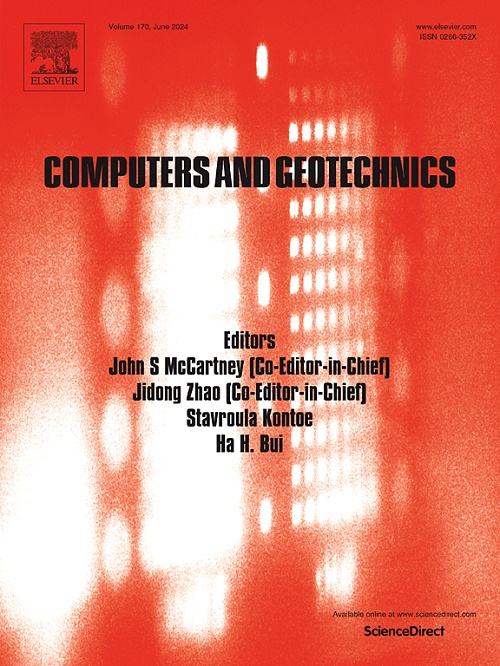A new integrated model of confinement-sensitive damage and bi-mechanism plasticity for rock-like materials
IF 5.3
1区 工程技术
Q1 COMPUTER SCIENCE, INTERDISCIPLINARY APPLICATIONS
引用次数: 0
Abstract
An integrated constitutive model has been developed for rock-like materials, incorporating confinement-sensitive damage and bi-mechanism plasticity. The model aims to improve the capability of the conventional damage model in depicting the strengthening and brittle-to-ductile transitions that occur under both active and passive confinement conditions. A thermodynamic analysis of energy transformation and dissipation, considering both damage and plasticity, underpins the model’s development. The model, rooted in damage-plastic theory, has been divided into two sub-models: (1) Confinement-Sensitive Model: This sub-model addresses the strengthening and ductility enhancements due to active confinement stress. It effectively captures the mechanical responses of rock-like materials under various levels of active confining stresses. (2) Endochronic Dilatancy Model: Based on endochronic theory, a separate dilatancy strain model is proposed, which effectively facilitates the interplay between lateral dilatancy and the growth of passive confining stress. Both sub-models, as well as the integrated model, have undergone validation using experimental data, including uniaxial tests, cyclic loading tests, actively confined tests, and passively confined tests of rock-like materials. These validations confirm the model’s accuracy and reliability in predicting the mechanical behavior of rock-like materials under complex loading conditions.
一类岩石材料的约束敏感损伤与双机制塑性综合新模型
建立了一种综合了约束敏感损伤和双机制塑性的类岩材料本构模型。该模型旨在提高传统损伤模型在描述主动和被动约束条件下发生的强化和脆性到延性转变方面的能力。考虑损伤和塑性的能量转换和耗散的热力学分析为模型的发展奠定了基础。该模型以损伤塑性理论为基础,分为两个子模型:(1)约束敏感模型:该子模型解决了主动约束应力引起的强化和延性增强问题。它有效地捕捉了岩石类材料在不同水平的主动围应力下的力学响应。(2)内时剪胀模型:基于内时理论,提出了一个单独的剪胀应变模型,有效地促进了侧向剪胀与被动围应力增长之间的相互作用。这两个子模型以及综合模型都经过了实验数据的验证,包括单轴试验、循环加载试验、主动侧限试验和被动侧限岩石材料试验。这些验证验证了该模型在预测岩石类材料在复杂载荷条件下的力学行为方面的准确性和可靠性。
本文章由计算机程序翻译,如有差异,请以英文原文为准。
求助全文
约1分钟内获得全文
求助全文
来源期刊

Computers and Geotechnics
地学-地球科学综合
CiteScore
9.10
自引率
15.10%
发文量
438
审稿时长
45 days
期刊介绍:
The use of computers is firmly established in geotechnical engineering and continues to grow rapidly in both engineering practice and academe. The development of advanced numerical techniques and constitutive modeling, in conjunction with rapid developments in computer hardware, enables problems to be tackled that were unthinkable even a few years ago. Computers and Geotechnics provides an up-to-date reference for engineers and researchers engaged in computer aided analysis and research in geotechnical engineering. The journal is intended for an expeditious dissemination of advanced computer applications across a broad range of geotechnical topics. Contributions on advances in numerical algorithms, computer implementation of new constitutive models and probabilistic methods are especially encouraged.
 求助内容:
求助内容: 应助结果提醒方式:
应助结果提醒方式:


